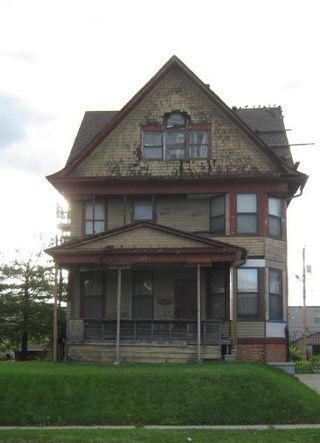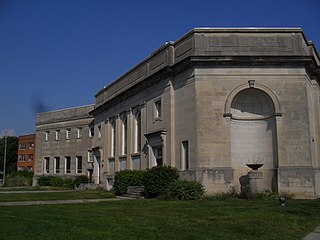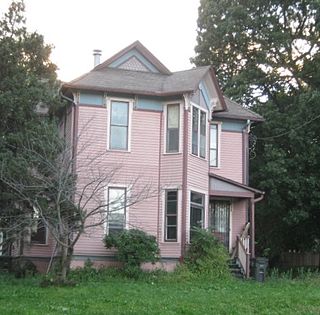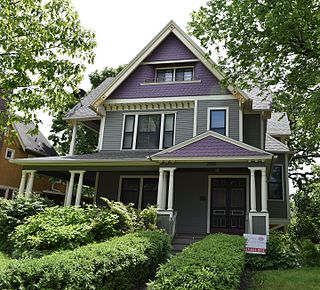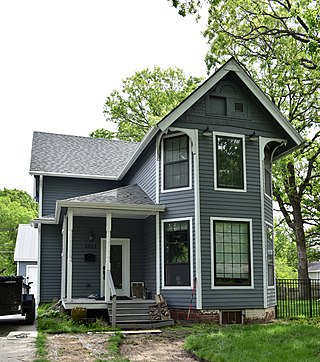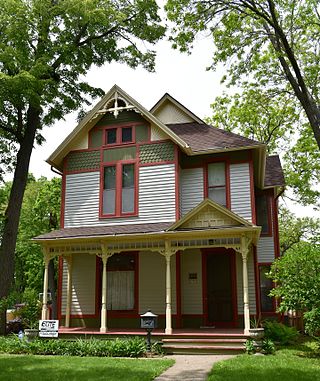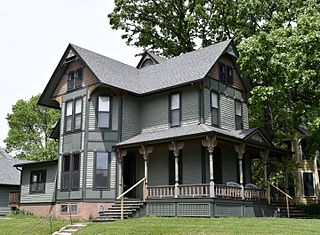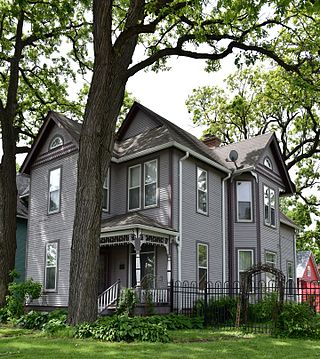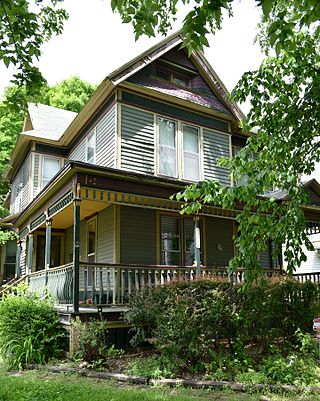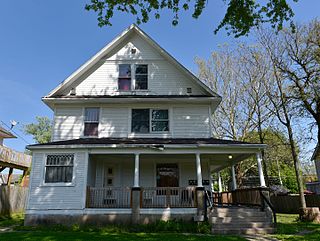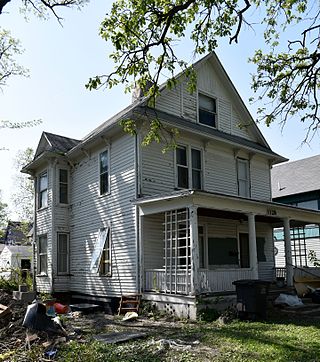Self-guided Sightseeing Tour #3 in Des Moines, United States
Legend
Tour Facts
4.2 km
0 m
Experience Des Moines in United States in a whole new way with our free self-guided sightseeing tour. This site not only offers you practical information and insider tips, but also a rich variety of activities and sights you shouldn't miss. Whether you love art and culture, want to explore historical sites or simply want to experience the vibrant atmosphere of a lively city - you'll find everything you need for your personal adventure here.
Individual Sights in Des MoinesSight 1: Edward B. and Nettie E. Evans House
The Edward B. and Nettie E. Evans House is a historic building located in Des Moines, Iowa, United States. It is significant as the best Free Classic Queen Anne style dwelling in the city. It is a transitional architectural style. The 2½-story structure shows elements of both the Queen Anne and the Neoclassical styles. The Queen Anne is found in the asymmetrical plan, the complex roof treatment, the full width and recessed porches, and contrasting shingle patterns. The Neoclassical is found in the window and door trim, the grouped classical porch columns, and the Palladian window in the attic level.
Wikipedia: Edward B. and Nettie E. Evans House (EN), Heritage Website
Sight 2: Basilica of Saint John
The Basilica of St. John is a Minor Basilica of the Catholic Church in the Drake neighborhood of Des Moines, Iowa, United States. It is also a parish church in the Diocese of Des Moines. The church building is listed on the National Register of Historic Places.
Wikipedia: Basilica of St. John (Des Moines, Iowa) (EN), Website, Heritage Website
Sight 3: Capt. Nicholas W. and Emma Johnson House
The Capt. Nicholas W. and Emma Johnson House is a historic building located in Des Moines, Iowa. The house is an unusual example in Des Moines of Châteauesque design elements added to a late Queen Anne style house. The design was attributed to Des Moines architect Oliver O. Smith and was built by local contractor Charles Weitz. The 2½-story brick structure features large massing, a prominent front-facing gable, two full-height polygonal side bays, steeply pitched hipped roof, smooth and rough wall surfaces, contrasting courses, and the fleur-de-lis motif executed in stone, ceramic tile, and glass.
Wikipedia: Capt. Nicholas W. and Emma Johnson House (EN), Heritage Website
Sight 4: George B. Peak House
The George B. Peak House, also known as New Life Eternity House, is a historic building located in Des Moines, Iowa, United States. It is a 2½-story brick dwelling that features a hipped roof with a flat deck, pedimented dormers, and a portico with freestanding columns. It was built for George M. Peak who came to Des Moines in 1888 from Kentucky. He worked as the local manager of the Equitable Life Assurance Society of the U.S. before he organized the Central Life Assurance Society of the U.S. in 1896. He served as president of the later until his death. He also promoted the Insurance Exchange building in Des Moines, and advocated for the construction of Keosauqua Way. After Peak died in 1923 the house was acquired for use as a fraternity and then a sorority house for Drake University. It has since been converted into a multi-family dwelling. The house was listed on the National Register of Historic Places in 1978.
Sight 5: Cottage Grove Church
Cottage Grove Avenue Presbyterian Church is a historic building located in Des Moines, Iowa, United States. It was listed on the National Register of Historic Places in 2016.
Wikipedia: Cottage Grove Avenue Presbyterian Church (EN), Website, Heritage Website
Sight 6: Francis M. Kirkham House
The Francis M. Kirkham House is a historic building located in Des Moines, Iowa, United States. It is a two-story dwelling that follows an irregular plan. It features a hipped roof with gablets, decorative wood shingles in the gable end, bargeboards, reeded panels that form the cornice, a gabled bay placed at an angle, bracketed eaves, and decorative window surrounds. The property on which it stands is a part of one of ten plats that were owned by Drake University. The University sold the lot to Francis M. Kirkham in 1886, and he had the house built by 1888 and resided in it. Kirkham was a Disciples of Christ minister and editor of the Christian Oracle. He was also one of the first trustees of Drake University. Its significance is attributed to the effect of the University's innovative financing techniques upon the settlement of the area around the campus. The house was listed on the National Register of Historic Places in 1988.
Sight 7: Richard T.C. Lord and William V. Wilcox House
The Richard T.C. Lord and William V. Wilcox House is a historic building located in Des Moines, Iowa, United States. This 2½-story dwelling follows a crossed gable plan that features elements of both the Colonial Revival and Queen Anne styles. The Colonial Revival influence includes grouped round porch columns and a pedimented porch entry. The Queen Anne influences include its massing, the brackets at the gable end, the second story corner porch, bargeboards, shingles, and the large porch. The property on which it stands is one of ten plats that were owned by Drake University. The house's significance is attributed to the effect of the university's innovative financing techniques upon the settlement of the area around the campus. Lord was a realtor, one of the organizers of the University Land Company, and he was a member of the first board of trustees of the university. He lived here from 1888 to around 1890 when he sold it to W.V. Wilcox, an insurance agent for Hawkeye Insurance Company. The house was listed on the National Register of Historic Places in 1988.
Wikipedia: Richard T.C. Lord and William V. Wilcox House (EN), Heritage Website
Sight 8: Nellie and Thomas Knotts House
The Nellie and Thomas Knotts House is a historic building located in Des Moines, Iowa, United States. This two-story dwelling is a gabled-ell type house that features a chamfered front section with gable-end detail, fishscale shingles, and a hipped porch. The property on which it stands is one of ten plats that were owned by Drake University. The University sold this lot and two others to Adam Howell in 1886. He sold this lot to Harold R. Howell in 1891. Nellie J. and Thomas H. Knotts acquired the property in 1893, and the house was built the following year. Knotts was president of Iowa Printing Company and then became a manager of the Union Mutual Life Insurance Company. He and his wife resided here until at least 1907. Its significance is attributed to the effect of the University's innovative financing techniques upon the settlement of the area around the campus. The house was listed on the National Register of Historic Places in 1988.
Wikipedia: Nellie and Thomas Knotts House (EN), Heritage Website
Sight 9: Mary A. and Caleb D. Scott House
The Mary A. and Caleb D. Scott House is a historic building located in Des Moines, Iowa, United States. This 2½-story dwelling features a hipped roof with gablets, various gables, reeded panels along cornice and base, and a shed-roofed porch with brackets, turned columns, and an open grill. The property on which it stands is one of ten plats that were owned by Drake University. The house's significance is attributed to the effect of the University's innovative financing techniques upon the settlement of the area around the campus. Charles H. Atkins and R.T.C. Lord owned the property between 1887 and 1888. Mary A. Scott bought the property in 1888 and the house was built the following year. She lived here in 1889 with Caleb D. Scott, a streetcar conductor, and James L. Scott, who was retired. The Scotts lived here until 1899. The house was listed on the National Register of Historic Places in 1988.
Wikipedia: Mary A. and Caleb D. Scott House (EN), Heritage Website
Sight 10: Anson O. Reynolds House
The Anson O. Reynolds House is a historic building located in Des Moines, Iowa, United States. This 2½-story dwelling features a hipped roof with a gablet, various gables, sunburst patterns, reeded panels, fishscale shingles, and bargeboards. The property on which it stands is one of ten plats that were owned by Drake University. The house's significance is attributed to the effect of the University's innovative financing techniques upon the settlement of the area around the campus. The University Land Company sold the property to S.B. Tuttle who was one of the first directors of the University Land Company. He sold it to the Reynolds in 1888, and they owned it until at least 1925. The house, built in 1890, was listed on the National Register of Historic Places in 1988.
Sight 11: Lampson P. Sherman House
The Lampson P. Sherman House is a historic building located in Des Moines, Iowa, United States. This 2½-story frame dwelling features crossed gables that create a cross shape, shingles in the gable ends, porch and gable end brackets, and turned porch columns. The property on which it stands is one of ten plats that were owned by Drake University. The house's significance is attributed to the effect of the University's innovative financing techniques upon the settlement of the area around the campus. Hoyt Sherman bought the property from the University Land Company in 1885. The house was built in 1888 and Sherman sold it to his brother Lampson, who was a student at Drake, two years later. The house remained in the Sherman family until 1904. It was listed on the National Register of Historic Places in 1988.
Sight 12: Mrs. Marian D. Vail/Prof. Charles Noyes Kinney House
The Mrs. Marian D. Vail-Prof. Charles Noyes Kinney House is a historic building located in Des Moines, Iowa, United States. This 2½-story frame dwelling follows an irregular plan and features a truncated hipped roof, various gables, a shed-roofed front porch with turned columns, fishscale shingles, and reeded panels along the gable ends. The property on which it stands is one of ten plats that were owned by Drake University. The house's significance is attributed to the effect of the University's innovative financing techniques upon the settlement of the area around the campus. Marian Vail acquired the property in 1884, and the house was built in 1889. Her daughter Jennie was a Drake student at that time. Charles Noyes Kinney, who bought the house in 1914, taught chemistry at the University for 30 years and served as the State Chemist for around 15 years. The house was listed on the National Register of Historic Places in 1988.
Wikipedia: Mrs. Marian D. Vail-Prof. Charles Noyes Kinney House (EN), Heritage Website
Sight 13: Dr. Richard and Paulina Stuart House
The Dr. Richard and Paulina Stuart House is a historic building located in Des Moines, Iowa, United States. This 2½-story frame dwelling follows an irregular plan and features a hipped roof, gablet, and various gables. The property on which it stands is one of ten plats that were owned by Drake University. The house's significance is attributed to the effect of the university's innovative financing techniques upon the settlement of the area around the campus. The property was bought by Mary A. Scott and her husband in 1889 from E.N. Curl, a stockholder in the University Land Company. They sold part of the lot in 1891 to Dr. Richard and Paulina D. Stuart. The house was built by 1895. The Stuarts continued to own the property until 1907. The house was listed on the National Register of Historic Places in 1988.
Wikipedia: Dr. Richard and Paulina Stuart House (EN), Heritage Website
Sight 14: Professor Charles O. Denny House
The Professor Charles O. Denny House is a historic building located in Des Moines, Iowa, United States. It is a 2½-story dwelling that follows an irregular plan. It features a hipped roof with gablets and additional gables, fishscale shingles, bargeboards, reeded panels that form the cornice, and a wraparound porch with a pedimented entry. The property on which it stands is one of ten plats that were owned by Drake University. The University sold the lot to C.O. Denny in 1892, and he had the house built the following year. Denny was a Latin professor at Drake and lived nearby. He seems to have bought the property for speculative purposes. Its significance is attributed to the effect of the University's innovative financing techniques upon the settlement of the area around the campus. The house was listed on the National Register of Historic Places in 1988.
Wikipedia: Professor Charles O. Denny House (EN), Heritage Website
Sight 15: Hill McClelland Bell House
The Hill McClelland Bell House is a historic building located in Des Moines, Iowa, United States. Built 1902, the 2½-story structure features a rectangular plan, a gable front, and a wrap-around porch. Decorative elements include wood shingles in the gable end, and some of the windows have a diamond mullion pattern. The house's significance is derived from its association with Hill McClelland Bell, president of Drake University from 1902 to 1918. This was a period of dramatic growth for the college. It was during his tenure that the institution was accredited with the North Central Association of Secondary Schools and Colleges, the establishment of a faculty pension, an increase in the school's endowment, a decrease in its debts, eminent professors joined the faculty, and several colleges were reorganized. Enrollment increased during this period of time, and five significant buildings were built on campus. The house was listed on the National Register of Historic Places in 1988.
Wikipedia: Hill McClelland Bell House (EN), Heritage Website
Sight 16: F. F. Odenweller-James P. and Nettie Morey House
The F. F. Odenweller-James P. and Nettie Morey House is a historic building located in Des Moines, Iowa, United States. It is a 1½-story frame cottage that follows an irregular plan. It features chamfered corners, Stick Style strips, moulded lintels, beaded corner boards, decorative shinglework, and a small front porch with a shed roof. The property on which it stands is one of ten plats that were owned by Drake University. The University sold the lot to Delos Cutler, one of the University Land Company organizers, in 1887. The next year he sold the property to F.F. Odenweller. After seven years the property was sold to A.A. Smith and O.E. Bowers. In 1896, the year the house was built, the property was sold to J.P. Morey, and he owned it for twenty-three years. Its significance is attributed to the effect of the University's innovative financing techniques upon the settlement of the area around the campus. The house was listed on the National Register of Historic Places in 1988.
Wikipedia: F. F. Odenweller-James P. and Nettie Morey House (EN), Heritage Website
Sight 17: John P. Simmons House
The John P. Simmons House is a historic building located in Des Moines, Iowa, United States. This simple 1½-story frame dwelling features a gable front, rectangular plan, and a hipped roof front porch. The property on which it stands is one of ten plats that were owned by Drake University. The house's significance is attributed to the effect of the University's innovative financing techniques upon the settlement of the area around the campus. Delos Cutler, one of the organizers of the University Land Company, acquired this lot and the one next to it in 1887. He sold them to F.F. Odenweller the following year. John P. Simmons bought this lot 25 in 1894, the same year the house was built. He either sold or mortgaged it to University Bank in 1900. The house was listed on the National Register of Historic Places in 1988.
Sight 18: Josiah Andrews House
The Josiah Andrews House is a historic building located in Des Moines, Iowa, United States. It is a 2½-story, rectangular, frame, front gable dwelling. It features Stick Style strips on the gable end, and brackets along the cornice. The property on which it stands is part of one of ten plats that were owned by Drake University. The university sold the lot to J. and H.L. Andrews in 1896, and they built this house at that time. Its significance is attributed to the effect of the university's innovative financing techniques upon the settlement of the area around the campus. The house was listed on the National Register of Historic Places in 1988.
Sight 19: Samuel A. and Margaret Stevenson House
The Samuel A. and Margaret Stevenson House is a historic building located in Des Moines, Iowa, United States. This is the best preserved example of the residential architecture that combines the Stick and Eastlake styles in the city. In the suburban areas of the city in the late 19th century this was one of the most common residential styles. Most of them have been either demolished, significantly altered, or lost most of their character by being covered over with siding. The Stevensons bought the property in 1889 from the Vermont Syndicate, who developed Kingman Place. They mortgaged the property for $2,687.50 to the syndicate immediately after they bought it, probably for them to build their house for them from a pattern book or stock plan design. The two-story wood-frame structure features exterior walls of painted clapboards, vertical and horizontal trim boards, and capped with a crossgabled roof. The house was listed on the National Register of Historic Places in 1985.
Wikipedia: Samuel A. and Margaret Stevenson House (EN), Heritage Website
Sight 20: Greek Orthodox Church of St. George

The Greek Orthodox Church of St. George in Des Moines, Iowa is a parish of the Greek Orthodox Archdiocese of America located in the Drake Neighborhood near Drake University. The building was listed on the National Register of Historic Places on February 28, 1997, as part of the architectural legacy of Proudfoot and Bird in Iowa.
Wikipedia: Greek Orthodox Church of St. George (Des Moines, Iowa) (EN), Heritage Website
Share
How likely are you to recommend us?
Disclaimer Please be aware of your surroundings and do not enter private property. We are not liable for any damages that occur during the tours.
GPX-Download For navigation apps and GPS devices you can download the tour as a GPX file.
